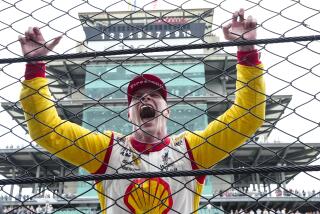For Danica Patrick, a trying season takes an unexpected turn
- Share via
Reporting from Indianapolis — — They were boos heard ‘round the world, a stinging rebuke aimed at Danica Patrick at the same spot that five years earlier was the stage for making her one of the most recognized women in sports.
Moments after a dreary qualifying run for Sunday’s Indianapolis 500, the driver was speaking on the public-address system at Indianapolis Motor Speedway when she blamed her problems on an “absolutely awful” race car and said “it’s not my fault.”
It was a flash point for many in the grandstands. Her fans had made Patrick, 28, the most popular driver in the Izod IndyCar Series, a role she skillfully finessed with sex-symbol marketing to become a singular household name a la Tiger and Kobe.
But there’s always been a flip side to Danicamania: She has won once in 86 races in her career. So when she complained about her car last weekend after qualifying 23rd in the 33-car field for the Indy 500, for many fans it smacked of breaking the cardinal rule that says drivers shouldn’t bad-mouth their crews.
Thus, a stunned Patrick was showered with boos. Media critics quickly followed, blasting her for “throwing her team under a bus,” “whining” and “acting like a diva.” Her teammate Tony Kanaan said “she definitely needs to change her attitude.”
There’s nothing new about race-car drivers getting booed. It’s a trademark of NASCAR’s temperamental Kyle Busch, for instance. But for Patrick, the IndyCar Series’ marquee attraction, it was novel.
“I’ve had boos over the years, but not like this,” Patrick said in an interview with The Times. “It doesn’t make me feel good, no.”
Patrick said she never meant to criticize her team, Andretti Autosport, and that she made that clear to each crew member afterward. But Sunday they still will face the issue that sparked her frustration, her slow No. 7 race car, and Patrick said they might have to gamble in the 94th Indy 500 against the likes of pole-sitter Helio Castroneves and former Indy 500 winners Dario Franchitti and Scott Dixon.
One possibility: making pit stops out of sequence with the leaders to gain track position.
“We’re probably going to have to maybe, maybe stay out or maybe come in [to pit] opposite the field,” she said. “Passing 22 cars is going to be hard.”
Even so, making passes early in the race also will be part of her strategy, mainly to avoid going a lap down to the leaders.
“Getting past the first lap is going to be important, just making sure you don’t get caught in any stupid stuff that happens when people are grabbing [for position] at the very beginning,” she said. “Then I think it’s going to be a matter of pedal to the metal for the first good chunk. I’ve got to get by some cars.”
Yet she also has to be patient in the 200-lap race.
“That’s something that I’ve been told since the first year I came here, it’s a long race,” she said. “As long as you don’t go a lap down, anything can happen.”
None of this was expected when the season opened, after Patrick caused another media frenzy when she began her exploratory foray into NASCAR stock car racing early this year.
After finishing a career-best fifth in the IndyCar points last year, she has struggled through the first five races this season, finishing in the top 10 once. She’s currently 16th in points.
Four of the first five races were on curvy road courses, which have never been Patrick’s strong suit, and she was expected to improve when she arrived in Indianapolis. She finished third in last year’s Indy 500.
Patrick typically has run well here ever since she rocketed to fame by nearly winning the Indy 500 as a rookie in 2005. But Patrick and her teammates have been relatively slow this month and are unable to figure out why.
“We mostly expected to do well here, so to not is a little bit shocking and disappointing,” Patrick said.
The boos were shocking too.
Patrick’s car handed so poorly during qualifying that the run left her on edge and, as her team’s owner, Michael Andretti, put it, “her adrenaline was through the roof.” The always forthright Patrick then gave her now-infamous interview.
“I had literally 60 seconds once I got out of the car and had my helmet off to talk to someone, and I was still really, really shaken up from the run and kind of had a quivering voice and shaky hands,” she said.
Taking a few more minutes before the interview “would have probably done myself some justice,” Patrick said. “On the other hand, it’s not like you’ve never seen me do something emotional before.”
How she fares Sunday could determine if the boos continue. But in terms of staying relevant in motor racing and as a celebrity, Patrick said it depends on what she does in her race car.
“At the end of the day,” she told reporters this month, “if I don’t do well with track position, there will be nothing for you guys to talk about.”
More to Read
Go beyond the scoreboard
Get the latest on L.A.'s teams in the daily Sports Report newsletter.
You may occasionally receive promotional content from the Los Angeles Times.










